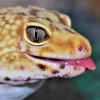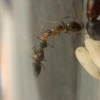
1. Location of collection: Verona, MS
2. Date of collection: 06/01/2020
3. Habitat of collection: Inside Log
4. Length: 1+ inch
5. Color, hue, pattern and texture: Black and Rusty Brown/Orange
6. Distinguishing characteristics: Orange looking legs
7. Distinguishing behavior: Wood worker
8. Nest description: Inside Log
9. Nuptial flight time and date: N/A


Sent from my iPhone using Tapatalk




















